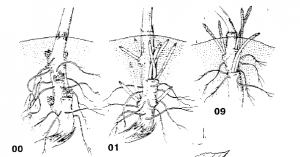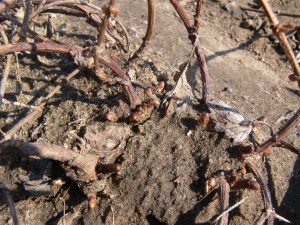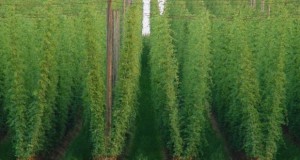By: Evan Elford – New Crop Specialist | OMAF/MRA | ONspecialtycrops | April 3, 2014
As the temperatures rise and the snow continues to melt, it’s time to start walking the hop yard and keeping an eye on plant growth stages while thinking about some spring management activities.
Table 1 provides a summary of hop plants by cultivar in the Simcoe research yard showing some evidence of growth (as of April 1, 2014). Figure 1 provides a visual representation from the BBCH scale of the ‘sprouting’ growth stage and Figure 2 is a photo of sprouting ‘Hallertauer’ taken on April 1.
Table 1: Number of hop plants as a percent (%) by cultivar observed sprouting on April 1, 2014 in Simcoe, Ontario and traditional hop maturity rating.
| Cultivar | Percent (%) hop plants at BBCH Principal Growth Stage 07-09: Sprouting |
| Centennial | 90 |
| Hallertauer | 85 |
| Nugget | 80 |
| Crystal | 75 |
| Northern Brewer | 75 |
| Naturalized (Bertwell) | 40 |
| Cascade | 40 |
| Galena | 35 |
| Sterling | 35 |
| Zeus (CTZ) | 35 |
| Chinook | 20 |

Fig 1: From BBCH Hop Scale, Principal Growth Stage 0: Sprouting (L-R: 00 Dormancy – rootstock without shoots; 01 Rootstock with shoots; 09 Emergence: first shoots emerge at the soil surface).

Fig 2: ‘Hallertauer’ hops with first shoots emerging in the University of Guelph research hop yard on April 1, 2014 Simcoe, Ontario.
During these early growth stages, there are some hop yard activities to be thinking about for April and early May:
Fertility: Hop plants require approximately 125-150 kg N/ha through the growing season (5 or 6 individual applications are typically made over the growing season as to not exceed 25 kg N/ha at any one time depending on the nutrient availability of the fertilizer). Consider spacing your fertility applications out every two weeks, starting with a side-dressing in late April-early May and ending in late June-early July. More information on hop fertility is available on this previous blog posting: http://onspecialtycrops.wordpress.com/2013/06/11/hop-fertility-overview-and-season-wrap-up-june-11-2013/ .
Irrigation and Structure: Check irrigation lines for splits or rodent damage. Flush lines and confirm water is reaching all emitters. Inspect cables, anchors, and posts to make sure they are all secure or if components are in need of repair.
Pruning: Remove remnants of the previous year’s plant growth. Some growers also prune the first 2-4 largest shoots in order to reduce variability amongst the bines, which are subsequently trained, and provide uniform cone maturity at harvest. Replicated research studies to verify this practice influences yield and uniformity have not yet been identified.
Stringing: Most growers will have already received their coir twine for this season. Remember to soak the coir in water at least 24 hours prior to stringing for easier tying. As the coir dries it will also shrink around the top cable which prevents sliding later in the season. More information on stringing and tools (such as w-clips) can be found on this previous blog posting: http://onspecialtycrops.wordpress.com/2013/05/14/hop-update-may-14-2013-stringing-trellising-and-irrigation/
Cover Crops: If you haven’t established a cover crop between your hop rows, now is the time to consider what species to plant. A helpful tool to determine the best cover crop for your site is the Midwest Cover Crop Council’s Cover Crop Selection Tool. This interactive module assists growers with selecting the best cover crop for your site based on your objectives (e.g., nitrogen source, weed fighter, quick growth). The database includes information based on Ontario research projects and addresses site specific conditions (e.g., location and soil type). Although the tool was designed for use in field crop rotations, the user can choose the ‘None’ option when asked for ‘Cash Crop’. Cover crop information sheets are subsequently created based on the answers provided by the user in the module. The Cover Crop Selection Tool can be found at the following link: http://mcccdev.anr.msu.edu/VertIndex.php
Some perennial species, such as clover, have been widely used as a cover crop in hop yards due to its nitrogen fixing ability (legume). However, if clover or other cover crops are not properly managed they can spread quickly and negatively impact hop growth due to increased competition with the hop plants for light, nutrients and water. Additionally, the nitrogen benefit from clover (and other legume cover crops) is typically only realised after the clover has been terminated and the plant begins to decompose. Another option for growers to consider is an annual cover crop such as a forage pea/oat mixture. Depending on the objectives for the site (as discussed with the Cover Crop Selection Tool), an annual cover crop may be easier to manage and will provide the option to plant a different cover crop species in future years.
We want to hear from you! Are you seeing any hop sprouting in your area of the province and what spring activities are you preparing for? Let us know by posting a comment below.
References:
Cover Crop Selection Tool. Midwest Cover Crops Council: http://www.mccc.msu.edu/selectorINTRO.html
Hop Growers of America. 2008. USA Hops: http://usahops.org/
Mahaffee, W.F., Pethybridge, S.J., and D.H. Gent (eds.). 2009. Compendium of Hop Diseases and Pests. The American Phytopathological Society, St. Paul.
Meier, U. (ed.). 2001. Stages of mono-and dicotyledonous plants, BBCH Monograph. Federal Biological Research Centre for Agriculture and Forestry Growth, Bonn.
Yakima Chief Hop Varietal Guide, 2013: http://yakimachief.com/wp-content/uploads/2013/05/Hop-Varietal-Guide-2013.pdf
To read the original article, click here.
 Ontario Hop Growers' Association The OHGA is a not-for-profit association of hop growers, families and enthusiasts who are interested in supporting the growth of the hop industry in Ontario.
Ontario Hop Growers' Association The OHGA is a not-for-profit association of hop growers, families and enthusiasts who are interested in supporting the growth of the hop industry in Ontario.


